Temperature regulators for radiators: selection and installation of thermostats
Thermostats are small in size, but very practical devices for controlling heat transfer in everyday life.Depending on the actual need, temperature regulators for radiators increase or reduce the volume of coolant. Agree, this is useful both for the well-being of the owners of the house/apartment and for their wallets.
For those wishing to purchase thermostats to equip radiators, we suggest that you familiarize yourself with a detailed description of the types of heat transfer control devices. We have presented and compared their control methods, operating principles, cost, and installation specifics. Our recommendations will help you choose the optimal variety.
We supplemented the information presented for consideration, collected and systematized for future buyers of heat regulators, with visual photo collections, diagrams, regulatory tables, and videos.
The content of the article:
The benefits of heating thermostats
It is known that the temperature in different rooms of the house cannot be the same. It is also not necessary to constantly maintain one or another temperature regime.
For example, in the bedroom at night it is necessary to lower the temperature to 17-18OC. It has a positive effect on sleep and helps get rid of headaches.
The optimal temperature in the kitchen is 19OC. This is due to the fact that there are a lot of heating equipment in the room, which generates additional heat. If the temperature in the bathroom is below 24-26OC, then the room will feel damp. Therefore, it is important to ensure high temperature here.
If the house has a children's room, then its temperature range may vary.For a child under one year old, a temperature of 23-24 will be requiredOC, for older children 21-22 will be enoughOC. In other rooms the temperature can vary from 18 to 22OWITH.
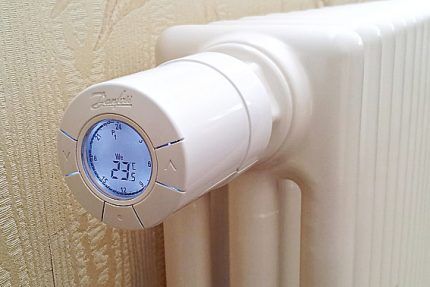
At night, you can lower the air temperature in all rooms. It is not necessary to maintain a high temperature in the home if the house will be empty for some time, as well as during sunny warm days, when some electrical appliances are operating that generate heat, etc.
In these cases, setting the thermostat has a positive effect on the microclimate - the air does not overheat and does not dry out.
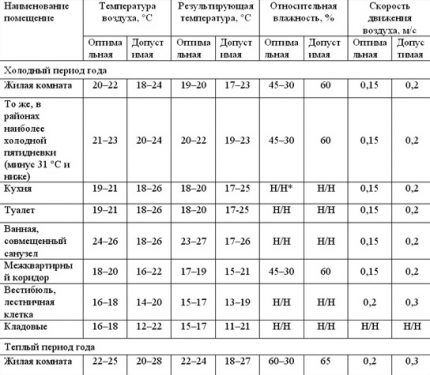
The thermostat solves the following problems:
- allows you to create a certain temperature regime in rooms for different purposes;
- saves boiler life, reduces the amount of consumables for system maintenance (up to 50%);
- It becomes possible to perform an emergency battery shutdown without shutting down the entire riser.
It should be remembered that using a thermostat it is impossible to increase the efficiency of the battery or increase its heat transfer. People with an individual heating system will be able to save on consumables. Residents of apartment buildings can only regulate the temperature in the room using a thermostat.
Let's figure out which ones exist types of thermostats, and how to make the right choice of equipment.
Types of thermostats and principles of operation
Thermostats are divided into three types:
- mechanical, with manual adjustment of coolant supply;
- electroniccontrolled by an external temperature sensor;
- semi-electronic, controlled by a thermal head with a bellows device.
The main advantage of mechanical devices is their low cost, ease of operation, clarity and consistency in work. During their operation there is no need to use additional energy sources.
The modification allows you to manually adjust amount of coolant, entering the radiator, thereby controlling the heat transfer of the batteries. The device is distinguished by high precision in adjusting the degree of heating.
A significant drawback of the design is that it does not have markings for adjustment, so setting up the unit will have to be done exclusively by experience. We will look at one of the balancing methods below.
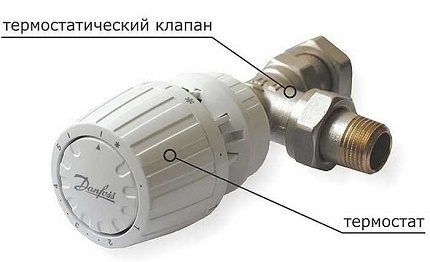
A mechanical thermostat consists of the following elements:
- regulator;
- drive;
- bellows filled with gas or liquid;
The substance contained in the bellows plays a key role. As soon as the position of the thermostat lever changes, the substance moves into the spool, thereby adjusting the position of the rod. The rod, under the action of the element, partially blocks the passage, limiting the entry of coolant into the battery.
Electronic thermostats are more complex designs, based on a programmable microprocessor. With it, you can set a certain temperature in the room by pressing several buttons on the controller. Some models are multifunctional, suitable for controlling a boiler, pump, or mixer.
The structure and operating principle of an electronic device are practically no different from its mechanical counterpart. Here the thermostatic element (bellows) has the shape of a cylinder, its walls are corrugated. It is filled with a substance that reacts to fluctuations in air temperature in the home.
As the temperature rises, the substance expands, resulting in pressure being generated on the walls, which promotes the movement of the rod, which automatically closes the valve. As the stem moves, the conductivity of the valve increases or decreases. If the temperature decreases, the working substance is compressed, as a result the bellows does not stretch, but the valve opens, and vice versa.
Bellows have high strength, long service life, and can withstand hundreds of thousands of compressions over several decades.
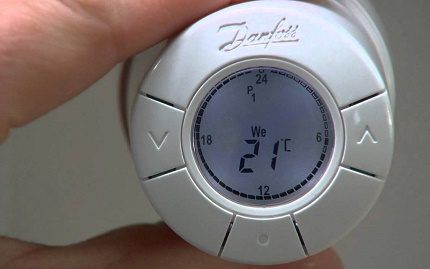
Electronic thermostats are conventionally divided into:
- Closed thermostats for heating radiators do not have an automatic temperature detection function, so they are adjusted manually. It is possible to adjust the temperature that will be maintained in the room and the permissible temperature fluctuations.
- Open thermostats can be programmed. For example, if the temperature drops by several degrees, the operating mode may change. It is also possible to set the response time of a particular mode and adjust the timer. Such devices are used mainly in industry.
Electronic regulators operate on batteries or a special battery that comes with a charger. Semi-electronic regulators are ideal for domestic purposes. They come with a digital display that shows the room temperature.
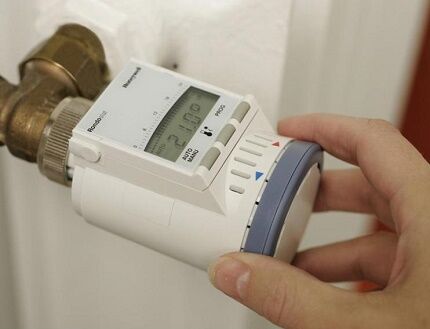
Gas-filled and liquid thermostats
When developing a regulator, a substance in a gaseous or liquid state (for example, paraffin) can be used as a thermostatic element. Based on this, devices are divided into gas-filled and liquid.
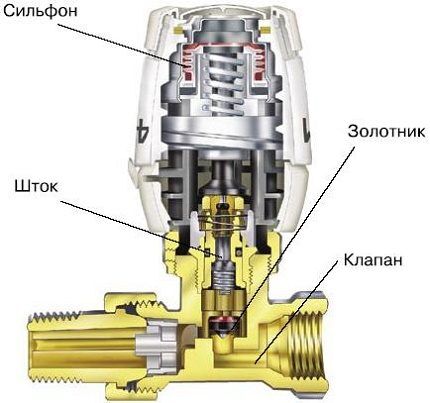
Gas-filled regulators have a long service life (from 20 years). The gaseous substance allows you to more smoothly and accurately regulate the air temperature in your home. The devices come with a sensor that determines the air temperature in the home.
Gas bellows respond faster to fluctuations in room temperature. Liquid ones are distinguished by higher accuracy in transmitting internal pressure to the moving mechanism. When choosing a regulator based on a liquid or gaseous substance, they are guided by the quality and service life of the unit.
Liquid and gas regulators can be of two types:
- with built-in sensor;
- with remote
Devices with built-in sensor installed horizontally because they require air circulation around them, which prevents heat from the pipe.
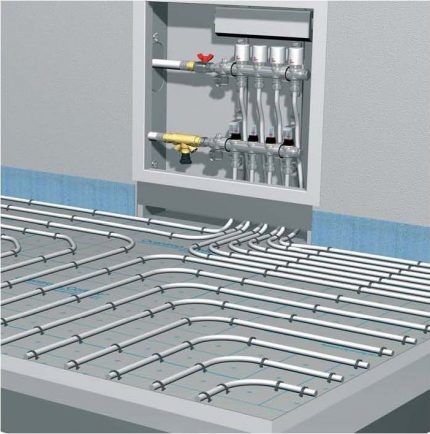
It is advisable to use remote sensors in cases where:
- the battery is covered with thick curtains;
- The thermostat is located in a vertical position;
- radiator depth exceeds 16 cm;
- the regulator is located at a distance of less than 10 cm from the window sill and more than 22 cm;
- The radiator is installed in a niche.
In these situations, the built-in sensor may not work correctly, so I use a remote one.
Typically the sensors are located at an angle of 90 degrees relative to the body heating radiator. In the case of parallel installation, its readings will be lost under the influence of heat emanating from the radiators.
Tips before you start installing your thermostat
We suggest that you familiarize yourself with the following tips that you should remember before installing the device.
- Before installing the locking and regulating mechanism, you should familiarize yourself with the manufacturer's recommendations.
- The design of temperature controllers contains fragile parts that can fail even with a slight impact. Therefore, care and attention should be exercised when working with the device.
- It is important to consider the following point - the valve must be installed so that the thermostat takes a horizontal position, otherwise warm air coming from the battery may enter the element, which will negatively affect its operation.
- There are arrows on the body that indicate in which direction the water should move. When installing, the direction of the water must also be taken into account.
- If a thermostatic element is installed on a single-pipe system, then bypasses must be installed under the pipes in advance, otherwise if one battery is disconnected, the entire heating system will fail.
Semi-electronic thermostats are mounted on batteries that are not covered with curtains, decorative grilles, various interior items, otherwise the sensor may not work correctly. It is also advisable to place the thermostatic sensor at a distance of 2-8 cm from the valve.
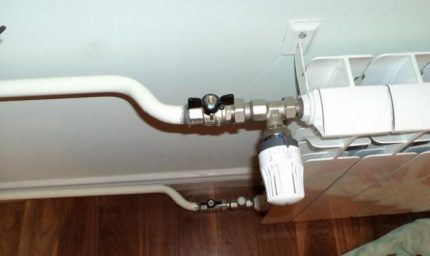
Electronic thermostats should not be installed in the kitchen, in the hall, in or near the boiler room, since such devices are more sensitive than semi-electronic ones. It is advisable to install devices in corner rooms, rooms with low temperatures (usually these are rooms located on the north side).
When choosing an installation location, you should be guided by the following general rules:
- There should be no devices near the thermostat that generate heat (for example, fan heaters), household appliances, etc.;
- It is unacceptable for the device to be exposed to sunlight and for it to be located in a place where there are drafts.
By remembering these simple rules, you can avoid a number of problems that arise when using the device.
Installation of automatic heating controllers
The instructions below will help you install the thermostat on both aluminum and bimetallic radiators.
If the radiator is connected to a working heating system, then the water should be drained from it.This can be done using a ball valve, shut-off valve or any other device that blocks the flow of water from the common riser.
After this, open the battery valve, located in the area where water enters the system, and turn off all taps.
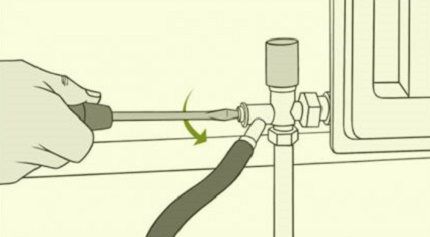
The next step is to remove the adapter. Before the procedure, the floor is covered with material that absorbs moisture well (napkins, towels, soft paper, etc.).
Frame thermostatic valve secure with an adjustable wrench. At the same time, use a second wrench to unscrew the nuts located on the pipe and the adapter, which is located in the battery itself. Next, unscrew the adapter from the body.
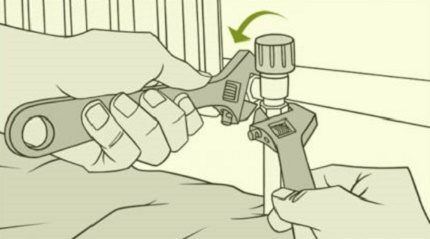
After dismantling the old adapter, a new one is installed. To do this, place an adapter in the structure, tighten the nuts and collar, and then thoroughly clean the internal threads using a clean material.
Next, the cleaned thread is wrapped several times with white plumbing tape (purchased separately in specialized stores), after which the adapter, as well as the radiator and corner nuts are tightly screwed on.
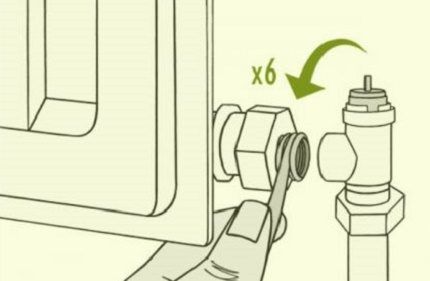
Once the installation of the adapter is completed, you need to begin removing the old collar and installing the new collar.In some cases, it is difficult to remove the collar, so its parts are cut out with a screwdriver or a hacksaw, and then torn off from each other.
Next comes the installation of the thermostat itself. To do this, following the arrows shown on the body, it is installed on the collar, after which, fixing the valve with an adjustable wrench, tighten the nut, which is located between the regulator and the valve. At the same time, use a second wrench to tighten the nut tightly.
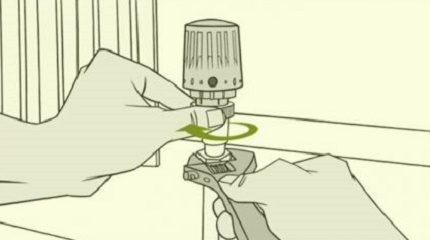
At the final stage, you need to open the valve, fill the battery with water, make sure the system is working, there are no leaks, and set a certain temperature. IN two-pipe system You can install thermostats on the top line.
Method for setting a mechanical thermostat
Once installed, it is important to set up mechanical models correctly. To do this, you need to close the windows and doors in the room to minimize heat loss, which will allow you to give a more accurate result of the work heating systems.
A thermometer is placed in the room, then the valve is turned off until it stops. In this position, the coolant will fill the radiator completely, which means that the heat transfer of the device will be maximum. After some time, it is necessary to record the resulting temperature.
Next, you need to turn the head all the way in the opposite direction. The temperature will begin to drop. When the thermometer shows optimal values for the room, the valve begins to open until the sound of water is heard and sudden heating occurs. In this case, the rotation of the head is stopped, fixing its position.
Conclusions and useful video on the topic
The video clearly shows how to set up a thermostat and implement it into the heating system. As an example, take the Living Eco automatic electronic controller from the Danfoss brand:
You can choose a thermostat based on your own wishes and financial capabilities. For domestic purposes, a mechanical and semi-electronic unit is ideal. Fans of smart technology may prefer functional electronic modifications. It is also possible to install devices without the involvement of specialists.
Do you have any questions about the topic proposed for consideration? Would you like to share your personal experience gained while installing or using a thermostat? Please write comments.




Actually, the heat doesn't break your bones. All these devices are installed to save money, not because of a good life. Previously, if it was hot in the room, you opened the window and at the same time ventilated the room. And now, with our wild prices for electricity and other fuels, many are starting to save on everything for business and idleness, closing even minimal ventilation. And so they live in the stale air.
Well, actually, by opening the window, there is a risk of creating a draft and catching a cold. Thermostats lower the temperature evenly and smoothly, even the most primitive ones. And the fact that the heat does not ache your bones is nonsense - the dry heat from heating does not bring anything useful for the skin and breathing, and there is little oxygen. So I set up regulation everywhere, I need an individual temperature regime.
Actually, it’s not “the heat doesn’t break the bones” but “the steam doesn’t break the bones.” And the saying is only suitable for bathhouses and those who like to steam.And in a domestic space - yes, it doesn’t hurt your bones, but the lack of a comfortable temperature and fresh air hurts your cardiovascular system once or twice. And a window is not enough here. A supply-exhaust system is needed. And this is a draft. And sometimes we have boiling water pouring into the heating system - in the room it’s 26-28 and no windows help when it’s below -10 outside.
My baby and I suffer a lot because of the dry air. It is impossible to sleep in our room. A regulator is definitely needed! Last winter there were frosts, we somehow survived them normally. And this winter is warm, we dry out in the room, even the humidifier can’t cope. Fresh and dry air are two different things!
What should be done with a Danfos mechanical thermostat after the end of the heating season and before the start of the heating season? Leave it open or closed? If so, at what mark or all the way? Or how?
We have mechanical type regulators from the developer. The batteries are “slightly alive”, it’s cold in the room, it’s on 5 (maximum)... I found out from the neighbors that they have hot batteries.
I called the management company, they promised to send a plumber. But the girl dispatcher said: you probably twisted them back and forth... you can’t twist them. The question is: why are they needed at all?
Excellent article, everything is clear and done in a simple way. By the way, I recently read an article on the website https://beis.kz/regulyatoryi-temperaturyi/, where I was already able to choose a high-quality temperature controller based on the information from the article. Thank you)
Can anyone tell me which organization I can contact about installing a thermostat on a heating radiator? I can’t find anyone in the plumbing services market who could help. They only offer replacement of the radiator itself.